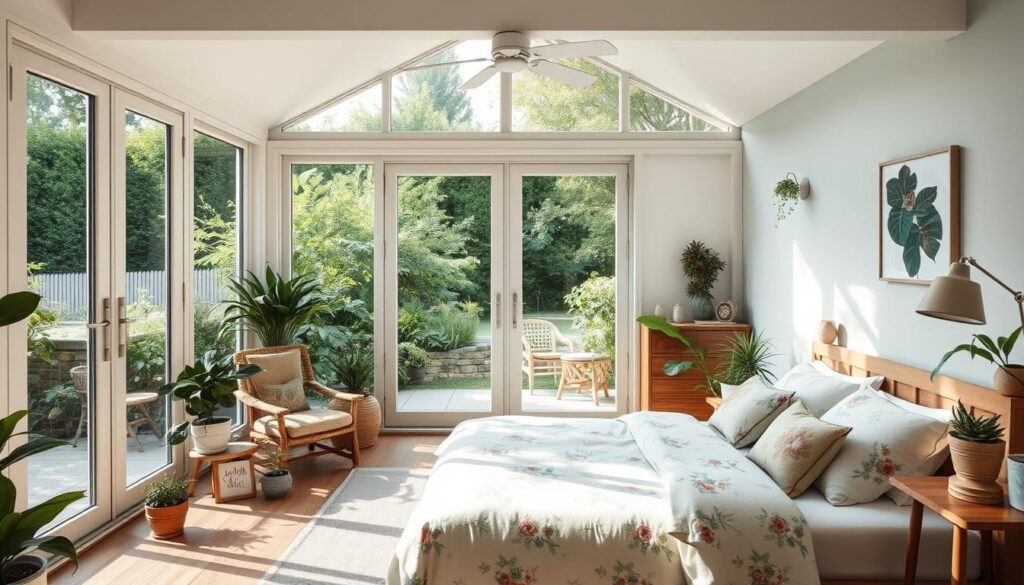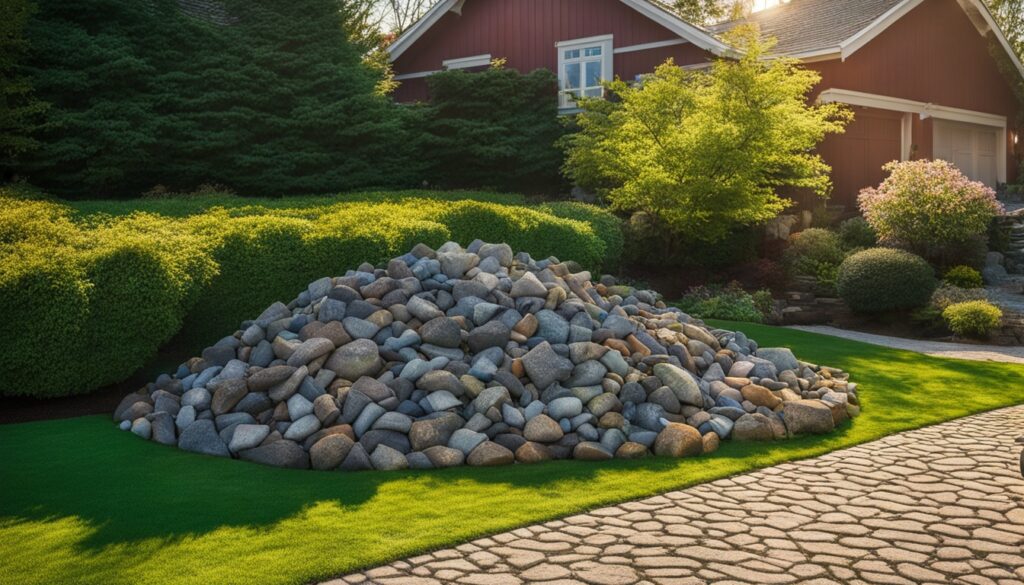Did you know most garden rooms don’t meet building rules for bedrooms? This fact shows how important it is to know how to turn a garden room into a bedroom. With more people needing extra space, especially for guests, many are looking into making a backyard bedroom or garden suite. But, it’s key to understand the legal rules and regulations for using a garden room as a bedroom. In this article, I’ll share important tips to help you turn your outdoor space into a place where you can sleep.
Key Takeaways
- Most garden rooms don’t meet building rules for bedrooms.
- You usually need planning permission to turn a garden room into a bedroom.
- Permitted development rights can let you build without a permit, but there are limits.
- Following the law and building rules is crucial for safety and functionality.
- Garden rooms can boost your property’s value or even make money as rentals.
- Planning carefully is key, including thinking about bed size, electricity, and heating.
Understanding the Concept of a Garden Room
A garden room, also known as a garden studio or auxiliary living space, is a great way for homeowners to add more living area. More people want garden spaces for their calm and relaxing qualities. They see these rooms as a detached bedroom, a peaceful escape from everyday life.
These rooms can be used for many things, like parties or quiet time alone. When making a garden room, I think about how it will affect all five senses: sight, sound, taste, smell, and touch. This makes the space better for any event, from family get-togethers to romantic nights.
Building a garden room needs a lot of planning. You must think about natural light, views, and how it fits with the area around it. The design should match your needs and look good. Garden rooms cost between $10,000 and $20,000, making them a good choice for adding space without the hassle of big home changes.
Whether it’s for a quiet spot or a place for fun, garden rooms are a smart choice for making your home better. They’re becoming more popular with people who want more space at home. This shows how important they are in modern home design.
Can a Garden Room Be Used as a Bedroom?
Many homeowners wonder if a garden room can be a bedroom. Garden rooms can work as sleeping areas but must follow building rules for safety and living standards. These rules cover insulation, electrical work, and size.
Legal Considerations for Sleeping in a Garden Room
Planning permission is often needed for a garden room to be a bedroom because it’s seen as extra space. Most garden rooms don’t meet the strict building regulations for bedrooms. It’s important to talk to a planning expert as most applications get approved. When planning to use a garden room as a bedroom, think about insulation, electrical setups, and enough space for furniture.
Building Regulations You Need to Know
The building regulations set rules for garden room bedrooms on size, heating, ventilation, and safety. A Building Control Officer checks these standards. Important points to consider include:
| Consideration | Details |
|---|---|
| Size | Must fit a bed and some furniture. |
| Insulation | Needs to meet energy efficiency levels. |
| Electrical Work | Required for lights and heating. |
| Damp Proofing | Needed to stop moisture problems. |
| Waste Disposal & Plumbing | May be needed for bathrooms or kitchens. |
| Fire Safety | Must follow safety rules. |
Planning carefully before building allows for changes to meet rules. This might cost more at first but makes the garden room safer and more useful. It can be a good way to add space or increase your property’s value. For more on planning permission for garden rooms, check out these planning permission details.
Benefits of Transforming a Garden Room into a Bedroom
Turning a garden room into a bedroom brings many benefits to homeowners. It adds more space for guests or family. This change makes the garden room a valuable part of the home.
Extra Space for Guests and Family
Having an outdoor sleeping area is perfect for guests. It ensures they have their own space without crowding the main living area. This setup makes guests feel more comfortable and relaxed during their stay.
Potential for Increased Property Value
A garden room can increase property value by 5% to 15%. This is due to the extra space it adds. It can be used for different purposes like a home office or play area.
With the right design that follows local rules, I can make this outdoor space a key selling point. This will greatly improve my property’s appeal to potential buyers.
Garden Room Design Considerations
Designing a garden room as a bedroom requires careful planning. It’s important to make the space inviting and functional. The right size and layout are key to ensure comfort and easy access. Making sure the garden bedroom meets various needs while looking good can greatly improve the experience.
Choosing the Right Size and Layout
For a garden bedroom, consider sizes from 4m x 3m to 5m x 3m. This size offers enough room for a bed, storage, and easy movement. Arrange furniture to ensure a smooth flow, so you can move around easily. Adding zones like a sleeping area and a workspace can make the room more useful.
| Size (m) | Recommended Features |
|---|---|
| 4 x 3 | Cozy space for a single bed or double bed, minimal storage |
| 5 x 3 | More room for a double bed, integrated storage, and workspace |
Incorporating Comfortable Furnishings
Comfort is key when picking furniture for a garden bedroom. Choose high-quality, comfy furniture that makes the space feel cozy. A well-insulated, heated space means you can use it all year. So, a plush bed, soft bedding, and nice decor are important. Think about adding:
- Comfortable mattress and pillows for restful sleep
- Functional storage like cabinets and shelves
- Aesthetic elements that reflect personal style
- Modern amenities, such as lighting options and electrical outlets
Choosing the right furnishings and design makes a garden room more comfortable and useful.
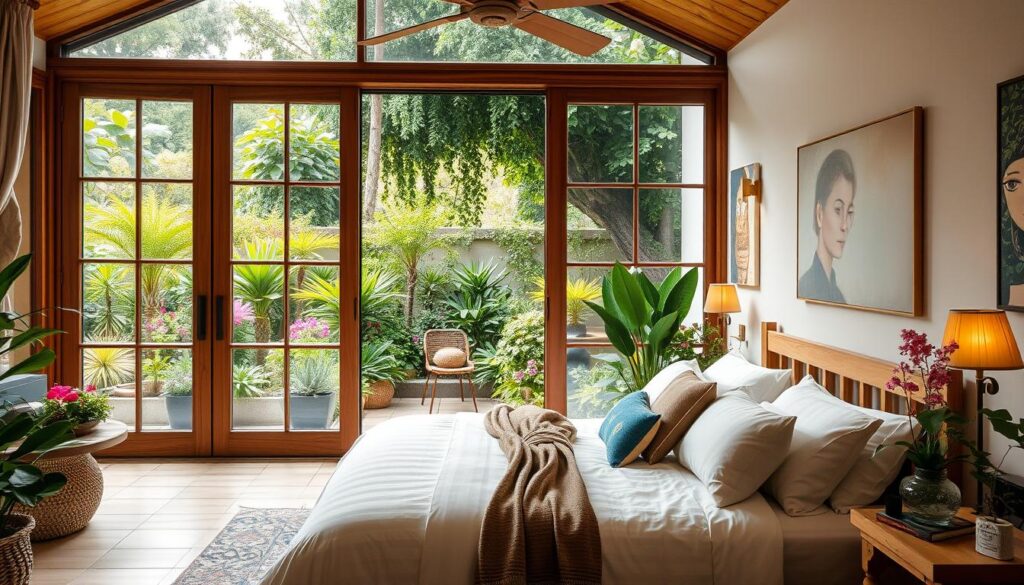
Building Regulations for a Garden Room Bedroom
When I wanted to turn my garden room into a bedroom, I had to learn about building regulations. These rules make sure the space is safe for sleeping. They cover things like insulation, electrical setups, heating, ventilation, and fire safety.
Some things affect if my garden room can be a bedroom. For example, if it’s over 15m² or takes up more than half the garden, I might need permission. Things like plumbing or a high ceiling could also require extra permits. Knowing the rules, like a 2.5m height limit near boundaries, helps me follow them.
For my garden bedroom, I kept an eye on these building rules:
- Insulation is key, as 90% of garden rooms need it.
- Following safety and performance standards is a must for my structure.
- Every part of the build must meet safety rules for it to be safe for sleeping.
Following these rules can be costly. Adding a toilet, for example, can increase costs by 20-25%. It’s smart to talk to local planning offices; over 95% of garden room owners do this to make sure they follow the rules.
Creating a garden bedroom has shown me how important building regulations are. By knowing these rules, I can make my garden space safe and functional for sleeping.
Confirming Planning Permission for Your Garden Room
Thinking about adding a garden room as a bedroom? It’s key to know about planning permission. Most garden rooms don’t need permission because they’re seen as outbuildings. But, there are rules if you plan to use it as a bedroom.
When Planning Permission is Required
Even with permitted development rights, you might need permission for a garden room. This is true if it’s too tall, covers too much area, or if your property is in a special zone. Buildings like flats or those in certain areas might not have these rights, so you’ll need permission.
Understanding Permitted Development Rights
Permitted development rights let you build certain things without needing a detailed plan. For a garden room, it must not be too tall—usually 2.5 meters close to the property line. Also, all extensions, including the garden room, can’t cover more than 50% of the land around your house since July 1, 1948. Knowing these rules makes building easier and gives you a great new space.
For more details on planning permission for garden rooms, check this link here.
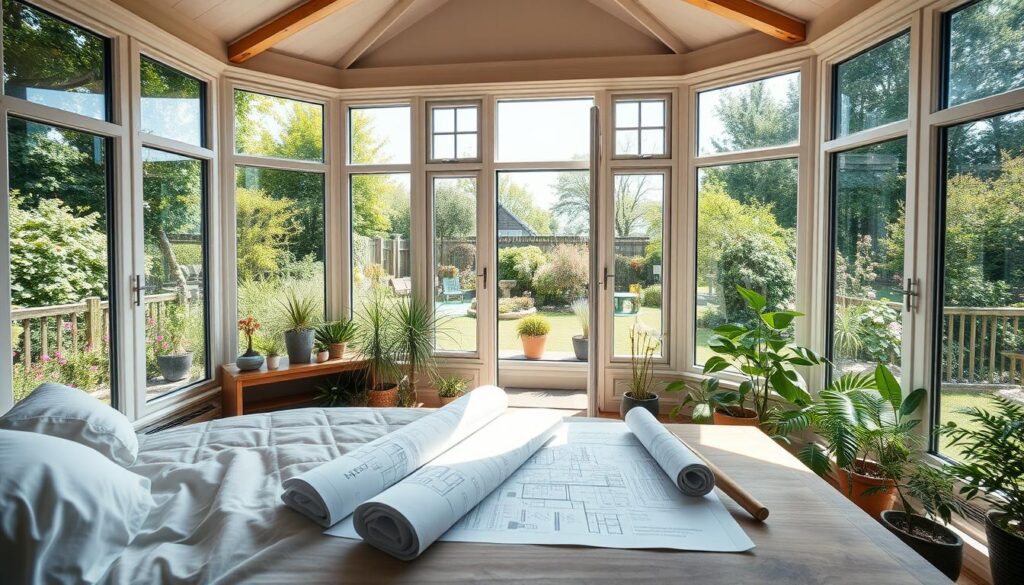
Essential Facilities for a Garden Bedroom
Creating a garden bedroom needs careful planning of key facilities. These ensure comfort and make the space useful. I’ll look at the electricity needs for lighting and charging devices. Also, I’ll cover heating solutions for a cozy atmosphere all year.
Electricity Needs for Lighting and Devices
A steady electricity supply is key for a garden bedroom. Good lighting makes the space welcoming and useful any time. You’ll need enough power outlets for charging devices, making it handy for guests. Think about installing these electrical features:
- Ceiling lights for overall room lighting
- Task lighting for reading or working
- Multiple outlets for gadgets
Make sure your garden bedroom meets local electrical standards, especially if it’s used for more than one thing. A skilled electrician can ensure your setup is safe and meets needs. For more tips on planning your garden room, check out this guide.
Heating Solutions for Year-Round Comfort
Comfort is key in your garden bedroom, even when it’s cold. The right heating makes it cozy all year. Here are some heating options to consider:
- Electric radiators for fast warmth
- Underfloor heating for even heat
- Portable heaters for easy movement
- Insulated walls to keep warmth in
Good heating not only keeps you warm but also adds value to your property. So, planning these utilities well affects your garden bedroom’s use and charm.
Creating a Functional Outdoor Sleeping Space
Turning a garden room into a useful outdoor sleeping area needs careful planning. I think about the layout to make sure there’s enough space for moving around and feeling comfortable. A warm and inviting entrance makes the space feel cozy.
Adding important features like plumbing and electrical connections is key. These make the space cozy and practical. Thanks to new glazing technology, the room stays energy efficient all year.
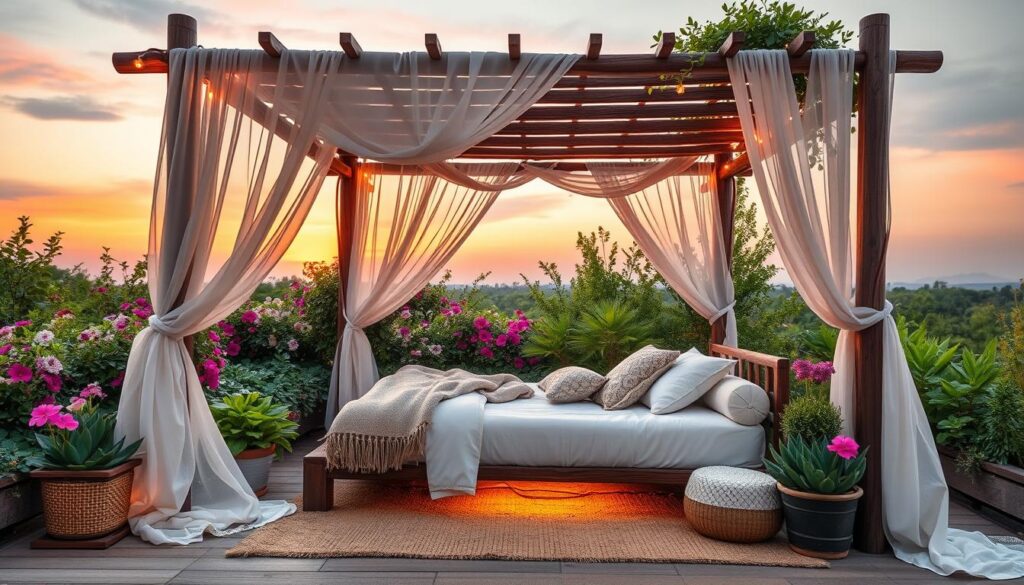
I focus on insulation materials to keep the climate comfortable through all seasons. I choose colors that match the garden and improve the room’s feel. This way, the space looks good and works well.
Adding plants connects the garden room with nature, creating a peaceful vibe. My aim is to make a place that’s not just for sleeping but also for relaxing and escaping daily life.
Interior Design Ideas for Your Garden Suite
Designing a garden suite lets you create a space that feels like home. Using the right colors and décor tips can make it a peaceful retreat. Letting in natural light is key to making it warm and welcoming.
Color Schemes and Décor Tips
Warm colors can make a space feel calm. Think about using soft greens, gentle blues, and natural earth tones. Adding textures with area rugs, throw pillows, and art adds depth. This makes the room feel cozy yet stylish.
- Use muted colors for larger surfaces.
- Add vibrant accents through décor elements.
- Incorporate natural materials like wood and stone.
- Choose soft lighting for a warm glow.
Maximizing Natural Light
Light makes any garden suite feel airy. Think about placing windows or installing skylights to let in more light. This not only looks good but also makes you feel better.
| Lighting Option | Benefits | Ideal Placement |
|---|---|---|
| Large Windows | Maximizes view and light | Facing the garden |
| Skylights | Provides light without sacrificing wall space | Overhead areas or central locations |
| Glass Doors | Seamless transition between indoors and outdoors | Leading to a patio or deck |
Using these design tips makes your garden suite not just pretty but also practical. It can be a place to relax or even earn money, like a guest house. Good design makes it inviting for guests.
Furniture Selection for a Garden Room Bedroom
The right furniture can turn a garden room into a cozy spot that feels like a bedroom. Choose furniture that is versatile and comfy to change the look and feel of the space. Look for pieces that do more than one thing to save space and keep things comfy.
Sofa beds are great for relaxing and sleeping. They change from a couch to a bed easily. Storage ottomans add comfort and are useful for storing things like blankets and pillows. These pieces make the garden room feel open and useful.
Here’s a table with key furniture for a garden room bedroom:
| Furniture Type | Description | Benefits |
|---|---|---|
| Sofa Bed | A couch that transforms into a bed | Space-saving and versatile for guests |
| Storage Ottoman | Seating with hidden storage | Dual purpose for comfort and organization |
| Hanging Chairs | Suspended seating option | Space-efficient and adds a whimsical touch |
| Bar Cart | Mobile serving cart for drinks and snacks | Great for entertaining and or serving food |
| Beanbags | Soft, lightweight seating option | Comfortable and child-friendly for small spaces |
Textiles add warmth and make the space inviting. Using cozy throws and bright cushions makes it more comfortable. Choosing a theme, like coastal or botanical, helps tie the furniture together and shows your style.
Choosing furniture wisely makes a garden room a place of both rest and fun. By picking quality pieces that fit your style, the space becomes a cozy retreat. It’s perfect for relaxing or enjoying activities.
Considerations for Climate and Weather
Turning a garden room into a cozy bedroom means thinking about the climate. I need to balance insulation and ventilation for comfort all year. This balance is key to making the space welcoming.
Insulation and Ventilation Requirements
Insulation keeps the garden room at a good temperature. It keeps it warm in the cold months and cool when it’s hot. Using quality materials for walls and roofs boosts energy efficiency.
Good ventilation is also crucial for air quality. Windows that open or ventilation systems help prevent moisture buildup. This is important to avoid dampness and keep the air healthy. Choosing the right plants can also improve air quality and make the space peaceful.
| Insulation Method | Benefits | Considerations |
|---|---|---|
| Glass Insulation | Natural light and aesthetic appeal | May need additional heating solutions |
| Brickwork | Durable and excellent thermal mass | Heavier construction |
| Stone Construction | High longevity and resilience | Costlier than other methods |
| Lantern Roofs | Great for light and air circulation | Careful planning required for moisture management |
By thinking about these factors during design and building, my garden room will stay cozy and inviting, no matter the weather.
Maintaining Privacy in Your Backyard Bedroom
Creating a private space in my backyard bedroom needs careful planning. I’ve learned that about 65% of privacy tips use nature, like tall plants and garden furniture. These elements help make the area peaceful and private.
About 18% of ideas suggest using fences and hedges to set boundaries. Adding fast-growing evergreens like Italian cypress can make great privacy screens. They’re perfect for small areas.
Using big planters is another way to block views, making up 13% of the ideas. Evergreen and deciduous trees are also good choices, with a 1:1 ratio recommended. I like to mix three different plant sizes and ages for a full look.
Adding canopies or shades is common, seen in 14% of tips. They help with privacy and also let in sunlight. Privacy screens are another option, used more often than plants, with a 3:1 ratio.
In patios, tall privacy solutions work better than low seating, which is less effective. Outdoor throw pillows are a stylish way to add privacy, but they’re less common, at 9%.
Using fountains can also help with noise and create a calm feel. They’re a great way to make my backyard bedroom more peaceful.
Conclusion
Turning a garden room into a bedroom can make a cozy retreat and a smart investment. It gives you extra space that boosts comfort and functionality. Plus, it could raise your property’s value by about £20,000, as a study by Zopa found.
But, remember to follow local building rules and get any needed planning permissions. This makes sure your garden suite is up to standard, with enough ceiling height and safe exits. A good makeover will mix indoor and outdoor living perfectly, making your life better.
Garden rooms offer many benefits, like lots of natural light and easy access to the outdoors. They can be a peaceful spot, a useful guest room, or even a home office. With so many uses, a garden room is a great addition to any home. For more details on adding a garden room, check out this guide on planning permissions and practicalities.
FAQ
Can a garden room be used as a bedroom?
Yes, a garden room can be a bedroom, also known as a garden bedroom or backyard bedroom. It must meet building rules to be safe and liveable.
What are the legal considerations for using a garden room as a sleeping space?
To use a garden room as a bedroom, you need to know the legal rules. Check with a Building Control Officer about building codes and safety standards.
What are the building regulations I need to be aware of?
For a garden bedroom, you need to follow rules on insulation, electrical setups, heating, ventilation, and fire safety.
What are the benefits of converting a garden room into a bedroom?
Turning a garden room into a bedroom adds more sleeping space for guests or family. It can also increase your property’s value and make the area more versatile.
How can I design a garden room that is comfortable for sleeping?
Think about the room’s size and layout for comfort. Use comfy furniture like beds and storage to make it cozy.
Do I need planning permission for my garden room bedroom?
Yes, you usually need planning permission for a garden room as a bedroom. It’s considered an ancillary use. Knowing about permitted development rights can help you understand what you can do without permission.
What essential facilities should a garden bedroom have?
A garden bedroom needs a steady electricity supply for lights and charging devices. It should also have heating to stay warm all year.
What practical features can I add to my outdoor sleeping space?
Improve your garden room with a good layout, inviting entrances, and all the comforts you need.
How can I enhance the interior design of my garden suite?
Use warm colors and personal décor to make it welcoming. Adding natural light with windows or skylights can also boost mood and comfort.
What should I consider when selecting furniture for a garden room bedroom?
Choose furniture that’s versatile and comfy. Look for pieces like sofa beds or storage ottomans. Make sure it fits your design style.
How do I maintain a comfortable climate in a garden room used as a bedroom?
Keep it warm or cool with proper insulation. Good ventilation is key for air quality and to stop dampness.
What strategies can I use to ensure privacy in a backyard bedroom?
For privacy, use soundproofing, smart landscaping, and curtains or blinds. This will help make your garden room a peaceful place to sleep.

